warning light Seat Ibiza 5D 2006 Owner's manual
[x] Cancel search | Manufacturer: SEAT, Model Year: 2006, Model line: Ibiza 5D, Model: Seat Ibiza 5D 2006Pages: 268, PDF Size: 8.14 MB
Page 5 of 268
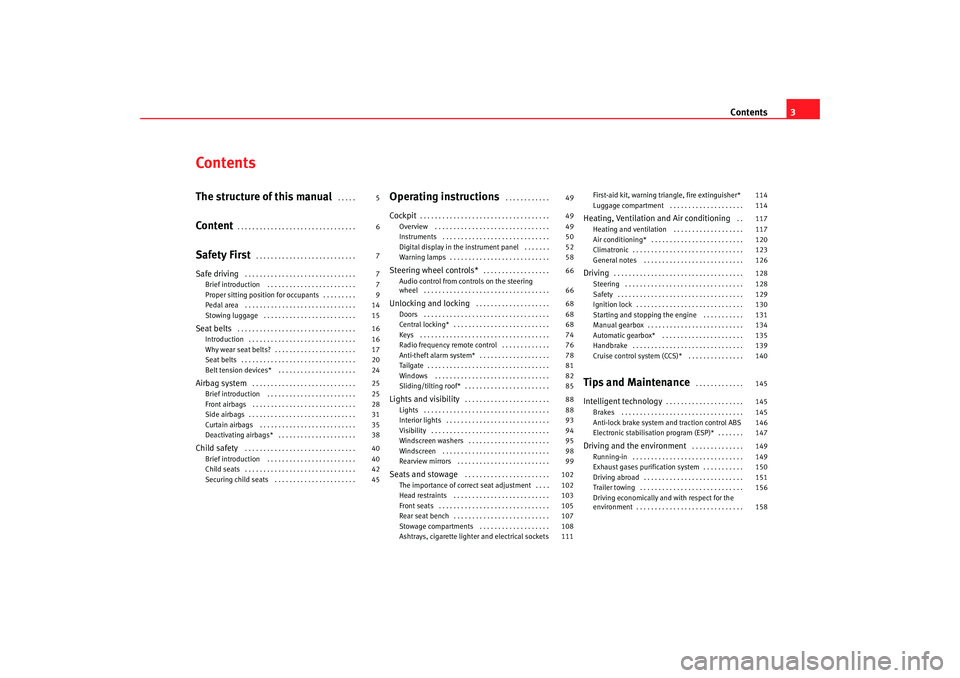
Contents3
ContentsThe structure of this manual
. . . . .
Content
. . . . . . . . . . . . . . . . . . . . . . . . . . . . . . . .
Safety First
. . . . . . . . . . . . . . . . . . . . . . . . . . .
Safe driving
. . . . . . . . . . . . . . . . . . . . . . . . . . . . . .
Brief introduction . . . . . . . . . . . . . . . . . . . . . . . .
Proper sitting position for occupants . . . . . . . . .
Pedal area . . . . . . . . . . . . . . . . . . . . . . . . . . . . . .
Stowing luggage . . . . . . . . . . . . . . . . . . . . . . . . .
Seat belts
. . . . . . . . . . . . . . . . . . . . . . . . . . . . . . . .
Introduction . . . . . . . . . . . . . . . . . . . . . . . . . . . . .
Why wear seat belts? . . . . . . . . . . . . . . . . . . . . . .
Seat belts . . . . . . . . . . . . . . . . . . . . . . . . . . . . . . .
Belt tension devices* . . . . . . . . . . . . . . . . . . . . .
Airbag system
. . . . . . . . . . . . . . . . . . . . . . . . . . . .
Brief introduction . . . . . . . . . . . . . . . . . . . . . . . .
Front airbags . . . . . . . . . . . . . . . . . . . . . . . . . . . .
Side airbags . . . . . . . . . . . . . . . . . . . . . . . . . . . . .
Curtain airbags . . . . . . . . . . . . . . . . . . . . . . . . . .
Deactivating airbags* . . . . . . . . . . . . . . . . . . . . .
Child safety
. . . . . . . . . . . . . . . . . . . . . . . . . . . . . .
Brief introduction . . . . . . . . . . . . . . . . . . . . . . . .
Child seats . . . . . . . . . . . . . . . . . . . . . . . . . . . . . .
Securing child seats . . . . . . . . . . . . . . . . . . . . . .
Operating instructions
. . . . . . . . . . . .
Cockpit
. . . . . . . . . . . . . . . . . . . . . . . . . . . . . . . . . . .
Overview . . . . . . . . . . . . . . . . . . . . . . . . . . . . . . .
Instruments . . . . . . . . . . . . . . . . . . . . . . . . . . . . .
Digital display in the instrument panel . . . . . . .
Warning lamps . . . . . . . . . . . . . . . . . . . . . . . . . . .
Steering wheel controls*
. . . . . . . . . . . . . . . . . .
Audio control from controls on the steering
wheel . . . . . . . . . . . . . . . . . . . . . . . . . . . . . . . . . .
Unlocking and locking
. . . . . . . . . . . . . . . . . . . .
Doors . . . . . . . . . . . . . . . . . . . . . . . . . . . . . . . . . .
Central locking* . . . . . . . . . . . . . . . . . . . . . . . . . .
Keys . . . . . . . . . . . . . . . . . . . . . . . . . . . . . . . . . . .
Radio frequency remote control . . . . . . . . . . . . .
Anti-theft alarm system* . . . . . . . . . . . . . . . . . . .
Tailgate . . . . . . . . . . . . . . . . . . . . . . . . . . . . . . . . .
Windows . . . . . . . . . . . . . . . . . . . . . . . . . . . . . . .
Sliding/tilting roof* . . . . . . . . . . . . . . . . . . . . . . .
Lights and visibility
. . . . . . . . . . . . . . . . . . . . . . .
Lights . . . . . . . . . . . . . . . . . . . . . . . . . . . . . . . . . .
Interior lights . . . . . . . . . . . . . . . . . . . . . . . . . . . .
Visibility . . . . . . . . . . . . . . . . . . . . . . . . . . . . . . . .
Windscreen washers . . . . . . . . . . . . . . . . . . . . . .
Windscreen . . . . . . . . . . . . . . . . . . . . . . . . . . . . .
Rearview mirrors . . . . . . . . . . . . . . . . . . . . . . . . .
Seats and stowage
. . . . . . . . . . . . . . . . . . . . . . .
The importance of correct seat adjustment . . . .
Head restraints . . . . . . . . . . . . . . . . . . . . . . . . . .
Front seats . . . . . . . . . . . . . . . . . . . . . . . . . . . . . .
Rear seat bench . . . . . . . . . . . . . . . . . . . . . . . . . .
Stowage compartments . . . . . . . . . . . . . . . . . . .
Ashtrays, cigarette lighter and electrical sockets First-aid kit, warning triangle, fire extinguisher*
Luggage compartment . . . . . . . . . . . . . . . . . . . .
Heating, Ventilation and Air conditioning
. .
Heating and ventilation . . . . . . . . . . . . . . . . . . .
Air conditioning* . . . . . . . . . . . . . . . . . . . . . . . . .
Climatronic . . . . . . . . . . . . . . . . . . . . . . . . . . . . . .
General notes . . . . . . . . . . . . . . . . . . . . . . . . . . .
Driving
. . . . . . . . . . . . . . . . . . . . . . . . . . . . . . . . . . .
Steering . . . . . . . . . . . . . . . . . . . . . . . . . . . . . . . .
Safety . . . . . . . . . . . . . . . . . . . . . . . . . . . . . . . . . .
Ignition lock . . . . . . . . . . . . . . . . . . . . . . . . . . . . .
Starting and stopping the engine . . . . . . . . . . .
Manual gearbox . . . . . . . . . . . . . . . . . . . . . . . . . .
Automatic gearbox* . . . . . . . . . . . . . . . . . . . . . .
Handbrake . . . . . . . . . . . . . . . . . . . . . . . . . . . . . .
Cruise control system (CCS)* . . . . . . . . . . . . . . .
Tips and Maintenance
. . . . . . . . . . . . .
Intelligent technology
. . . . . . . . . . . . . . . . . . . . .
Brakes . . . . . . . . . . . . . . . . . . . . . . . . . . . . . . . . .
Anti-lock brake system and traction control ABS
Electronic stabilisation program (ESP)* . . . . . . .
Driving and the environment
. . . . . . . . . . . . . .
Running-in . . . . . . . . . . . . . . . . . . . . . . . . . . . . . .
Exhaust gases purification system . . . . . . . . . . .
Driving abroad . . . . . . . . . . . . . . . . . . . . . . . . . . .
Trailer towing . . . . . . . . . . . . . . . . . . . . . . . . . . . .
Driving economically and with respect for the
environment . . . . . . . . . . . . . . . . . . . . . . . . . . . . .
5
6
7
7
7
9
14
15
16
16
17
20
24
25
25
28
31
35
38
40
40
42
45 49
49
49
50
52
58
66
66
68
68
68
74
76
78
81
82
85
88
88
93
94
95
98
99
102
102
103
105
107
108
111 114
114
117
117
120
123
126
128
128
129
130
131
134
135
139
140
145
145
145
146
147
149
149
150
151
156
158
ibiza_angles_0706_DEF Seite 3 Freitag, 1. September 2006 1:18 13
Page 10 of 268
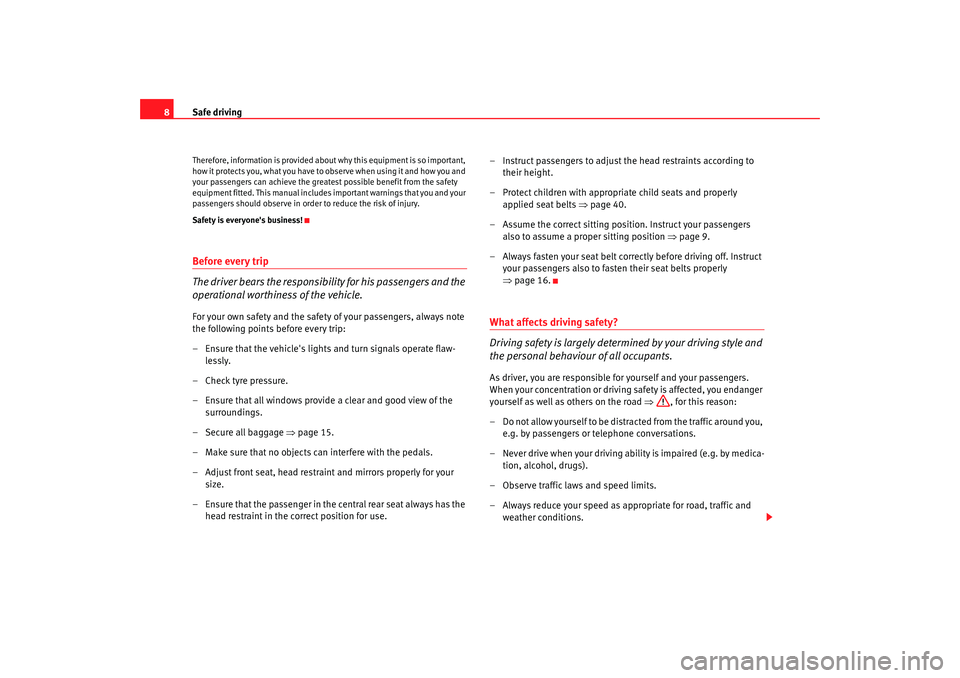
Safe driving
8Therefore, information is provided about why this equipment is so important,
how it protects you, what you have to observe when using it and how you and
your passengers can achieve the greatest possible benefit from the safety
equipment fitted. This manual includes important warnings that you and your
passengers should observe in order to reduce the risk of injury.
Safety is everyone's business!Before every trip
The driver bears the responsibility for his passengers and the
operational worthiness of the vehicle.For your own safety and the safety of your passengers, always note
the following points before every trip:
– Ensure that the vehicle's lights and turn signals operate flaw- lessly.
– Check tyre pressure.
– Ensure that all windows provide a clear and good view of the surroundings.
– Secure all baggage ⇒page 15.
– Make sure that no objects can interfere with the pedals.
– Adjust front seat, head restraint and mirrors properly for your size.
– Ensure that the passenger in the central rear seat always has the head restraint in the correct position for use. – Instruct passengers to adjust the head restraints according to
their height.
– Protect children with appropriate child seats and properly applied seat belts ⇒page 40.
– Assume the correct sitting position. Instruct your passengers also to assume a proper sitting position ⇒ page 9.
– Always fasten your seat belt correctly before driving off. Instruct your passengers also to fasten their seat belts properly
⇒page 16.
What affects driving safety?
Driving safety is largely determined by your driving style and
the personal behaviour of all occupants.As driver, you are responsible for yourself and your passengers.
When your concentration or driving safety is affected, you endanger
yourself as well as others on the road ⇒, for this reason:
– Do not allow yourself to be distracted from the traffic around you, e.g. by passengers or telephone conversations.
– Never drive when your driving ability is impaired (e.g. by medica- tion, alcohol, drugs).
– Observe traffic laws and speed limits.
– Always reduce your speed as appropriate for road, traffic and weather conditions.
ibiza_angles_0706_DEF Seite 8 Freitag, 1. September 2006 1:18 13
Page 11 of 268
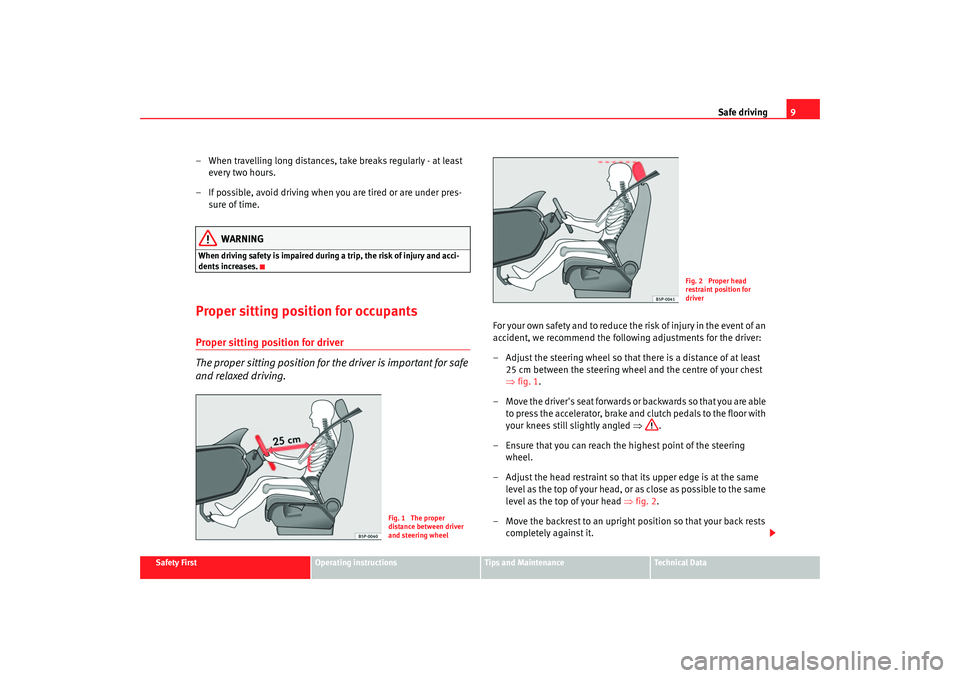
Safe driving9
Safety First
Operating instructions
Tips and Maintenance
Te c h n i c a l D a t a
– When travelling long distances, take breaks regularly - at least
every two hours.
– If possible, avoid driving when you are tired or are under pres- sure of time.
WARNING
When driving safety is impaired during a trip, the risk of injury and acci-
dents increases.Proper sitting position for occupantsProper sitting position for driver
The proper sitting position for the driver is important for safe
and relaxed driving.
For your own safety and to reduce the risk of injury in the event of an
accident, we recommend the following adjustments for the driver:
– Adjust the steering wheel so that there is a distance of at least
25 cm between the steering wheel and the centre of your chest
⇒ fig. 1.
– Move the driver's seat forwards or backwards so that you are able to press the accelerator, brake and clutch pedals to the floor with
your knees still slightly angled ⇒.
– Ensure that you can reach the highest point of the steering wheel.
– Adjust the head restraint so that its upper edge is at the same level as the top of your head, or as close as possible to the same
level as the top of your head ⇒fig. 2.
– Move the backrest to an upright position so that your back rests completely against it.
Fig. 1 The proper
distance between driver
and steering wheel
Fig. 2 Proper head
restraint position for
driver
ibiza_angles_0706_DEF Seite 9 Freitag, 1. September 2006 1:18 13
Page 18 of 268
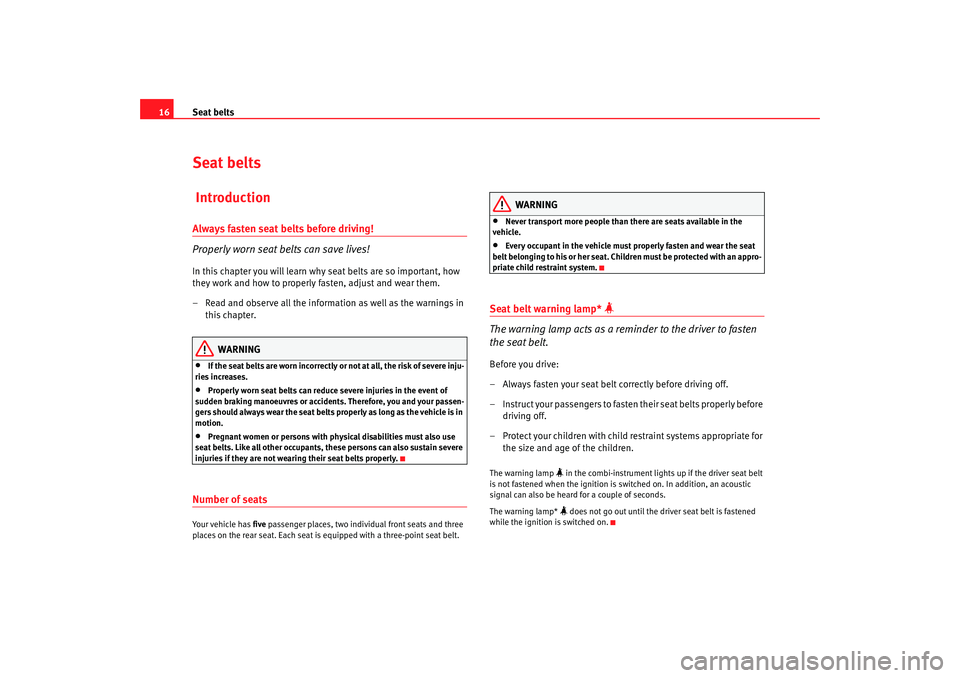
Seat belts
16Seat belts IntroductionAlways fasten seat belts before driving!
Properly worn seat belts can save lives!In this chapter you will learn why seat belts are so important, how
they work and how to properly fasten, adjust and wear them.
– Read and observe all the information as well as the warnings in
this chapter.
WARNING
•
If the seat belts are worn incorrectly or not at all, the risk of severe inju-
ries increases.
•
Properly worn seat belts can reduce severe injuries in the event of
sudden braking manoeuvres or accidents. Therefore, you and your passen-
gers should always wear the seat belts properly as long as the vehicle is in
motion.
•
Pregnant women or persons with physical disabilities must also use
seat belts. Like all other occupants, these persons can also sustain severe
injuries if they are not wearing their seat belts properly.
Number of seatsYour vehicle has five passenger places, two individual front seats and three
places on the rear seat. Each seat is equipped with a three-point seat belt.
WARNING
•
Never transport more people than there are seats available in the
vehicle.
•
Every occupant in the vehicle must properly fasten and wear the seat
belt belonging to his or her seat. Children must be protected with an appro-
priate child restraint system.
Seat belt warning lamp*
The warning lamp acts as a reminder to the driver to fasten
the seat belt.Before you drive:
– Always fasten your seat belt correctly before driving off.
– Instruct your passengers to fasten their seat belts properly before driving off.
– Protect your children with child restraint systems appropriate for the size and age of the children.The warning lamp
in the combi-instrument lights up if the driver seat belt
is not fastened when the ignition is switched on. In addition, an acoustic
signal can also be heard for a couple of seconds.
The warning lamp* does not go out until the driver seat belt is fastened
while the ignition is switched on.
ibiza_angles_0706_DEF Seite 16 Freitag, 1. September 2006 1:18 13
Page 26 of 268
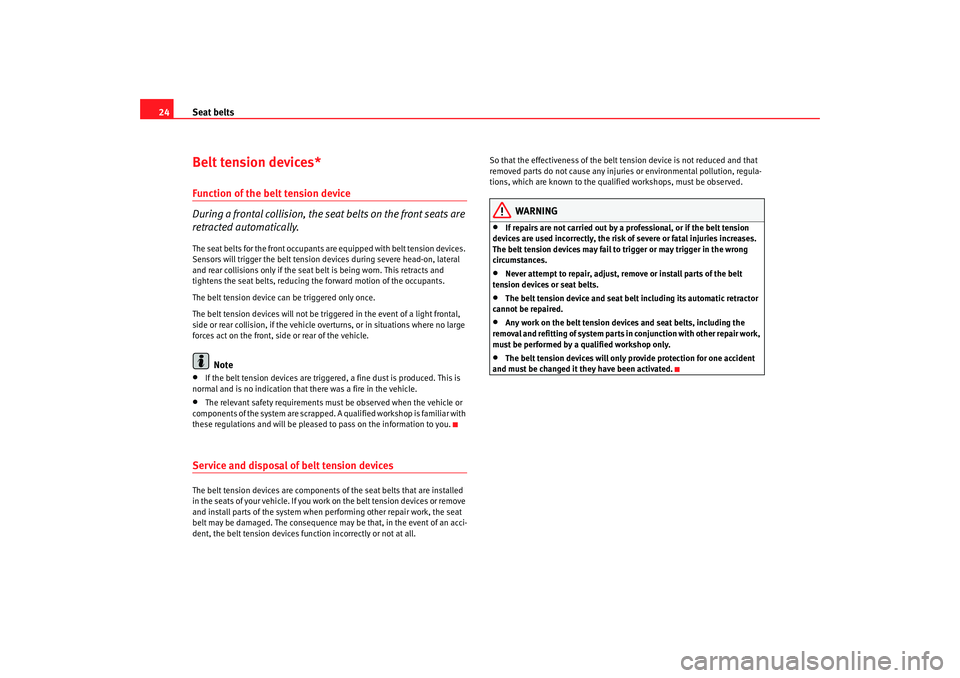
Seat belts
24Belt tension devices*Function of the belt tension device
During a frontal collision, the seat belts on the front seats are
retracted automatically.The seat belts for the front occupants are equipped with belt tension devices.
Sensors will trigger the belt tension devices during severe head-on, lateral
and rear collisions only if the seat be lt is being worn. This retracts and
tightens the seat belts, reducing the forward motion of the occupants.
The belt tension device can be triggered only once.
The belt tension devices will not be triggered in the event of a light frontal,
side or rear collision, if the vehicle overturns, or in situations where no large
forces act on the front, side or rear of the vehicle.
Note
•
If the belt tension devices are triggered, a fine dust is produced. This is
normal and is no indication that there was a fire in the vehicle.
•
The relevant safety requirements must be observed when the vehicle or
components of the system are scrapped. A qualified workshop is familiar with
these regulations and will be pleased to pass on the information to you.
Service and disposal of belt tension devicesThe belt tension devices are components of the seat belts that are installed
in the seats of your vehicle. If you work on the belt tension devices or remove
and install parts of the system when performing other repair work, the seat
belt may be damaged. The consequence may be that, in the event of an acci-
dent, the belt tension devices func tion incorrectly or not at all. So that the effectiveness of the belt tension device is not reduced and that
removed parts do not cause any injuries or environmental pollution, regula-
tions, which are known to the qualified workshops, must be observed.
WARNING
•
If repairs are not carried out by a professional, or if the belt tension
devices are used incorrectly, the risk of severe or fatal injuries increases.
The belt tension devices may fail to trigger or may trigger in the wrong
circumstances.
•
Never attempt to repair, adjust, remove or install parts of the belt
tension devices or seat belts.
•
The belt tension device and seat belt including its aut omatic retractor
cannot be repaired.
•
Any work on the belt tension devices and seat belts, including the
removal and refitting of system parts in conjunction with other repair work,
must be performed by a qualified workshop only.
•
The belt tension devices will only provide protection for one accident
and must be changed it they have been activated.
ibiza_angles_0706_DEF Seite 24 Freitag, 1. September 2006 1:18 13
Page 29 of 268
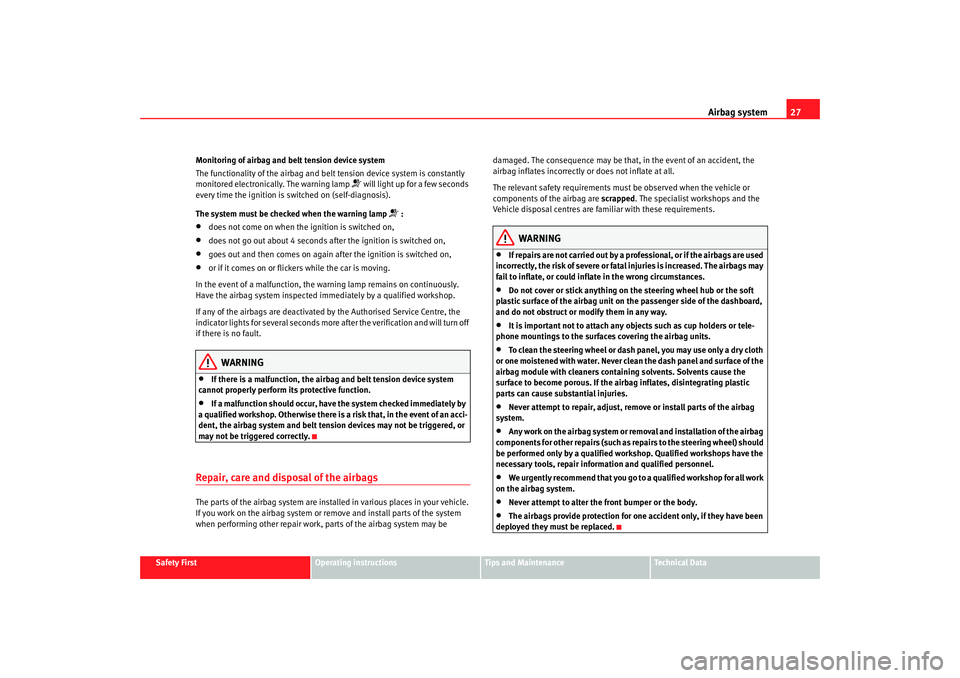
Airbag system27
Safety First
Operating instructions
Tips and Maintenance
Te c h n i c a l D a t a
Monitoring of airbag and belt tension device system
The functionality of the airbag and belt tension device system is constantly
monitored electronically. The warning lamp
will light up for a few seconds
every time the ignition is switched on (self-diagnosis).
The system must be checked when the warning lamp
:
•
does not come on when the ignition is switched on,
•
does not go out about 4 seconds after the ignition is switched on,
•
goes out and then comes on again after the ignition is switched on,
•
or if it comes on or flickers while the car is moving.
In the event of a malfunction, the warning lamp remains on continuously.
Have the airbag system inspected immediately by a qualified workshop.
If any of the airbags are deactivated by the Authorised Service Centre, the
indicator lights for several seconds more after the verification and will turn off
if there is no fault.
WARNING
•
If there is a malfunction, the airbag and belt tension device system
cannot properly perform its protective function.
•
If a malfunction should occur, have the system checked immediately by
a qualified workshop. Otherwise there is a risk that, in the event of an acci-
dent, the airbag system and belt tens ion devices may not be triggered, or
may not be triggered correctly.
Repair, care and disposal of the airbagsThe parts of the airbag system are installed in various places in your vehicle.
If you work on the airbag system or remove and install parts of the system
when performing other repair work, parts of the airbag system may be damaged. The consequence may be that, in the event of an accident, the
airbag inflates incorrectly or does not inflate at all.
The relevant safety requirements must be observed when the vehicle or
components of the airbag are
scrapped. The specialist workshops and the
Vehicle disposal centres are familiar with these requirements.
WARNING
•
If repairs are not carried out by a professional, or if the airbags are used
incorrectly, the risk of severe or fatal injuries is increased. The airbags may
fail to inflate, or could inflate in the wrong circumstances.
•
Do not cover or stick anything on the steering wheel hub or the soft
plastic surface of the airbag unit on the passenger side of the dashboard,
and do not obstruct or modify them in any way.
•
It is important not to attach any objects such as cup holders or tele-
phone mountings to the surfaces covering the airbag units.
•
To clean the steering wheel or dash panel, you may use only a dry cloth
or one moistened with water. Never clean the dash panel and surface of the
airbag module with cleaners containing solvents. Solvents cause the
surface to become porous. If the airbag inflates, disintegrating plastic
parts can cause substantial injuries.
•
Never attempt to repair, adjust, remove or install parts of the airbag
system.
•
Any work on the airbag system or removal and installation of the airbag
components for other repairs (such as repairs to the steering wheel) should
be performed only by a qualified wo rkshop. Qualified workshops have the
necessary tools, repair information and qualified personnel.
•
We urgently recommend that you go to a qualified workshop for all work
on the airbag system.
•
Never attempt to alter the front bumper or the body.
•
The airbags provide protection for one accident only, if they have been
deployed they must be replaced.
ibiza_angles_0706_DEF Seite 27 Freitag, 1. September 2006 1:18 13
Page 30 of 268
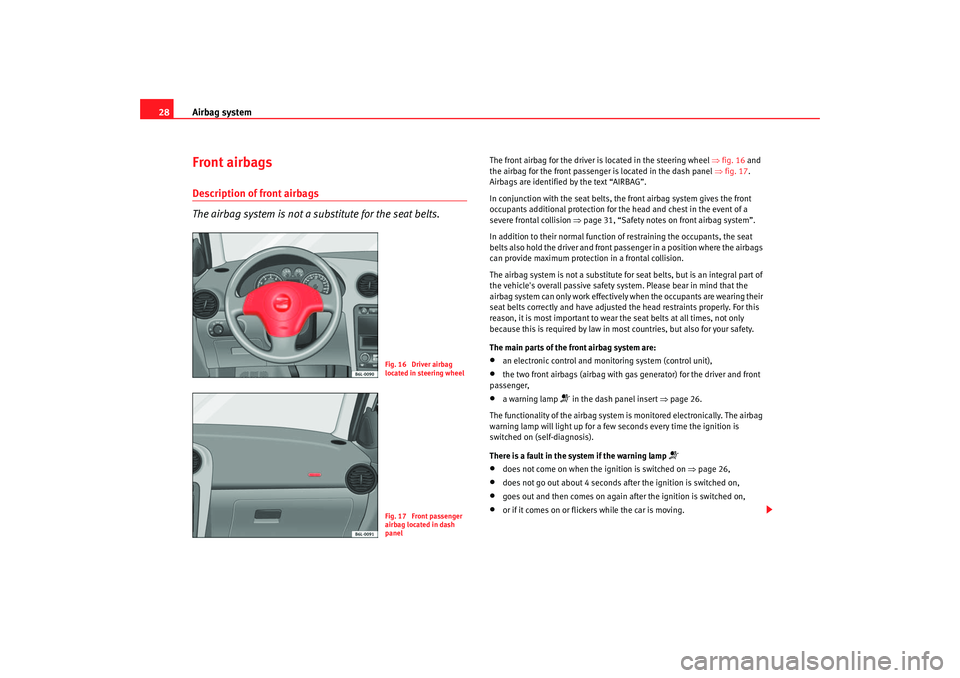
Airbag system
28Front airbagsDescription of front airbags
The airbag system is not a substitute for the seat belts.
The front airbag for the driver is located in the steering wheel ⇒fig. 16 and
the airbag for the front passenger is located in the dash panel ⇒fig. 17.
Airbags are identified by the text “AIRBAG”.
In conjunction with the seat belts, the front airbag system gives the front
occupants additional protection for the head and chest in the event of a
severe frontal collision ⇒page 31, “Safety notes on front airbag system”.
In addition to their normal function of restraining the occupants, the seat
belts also hold the driver and front passenger in a position where the airbags
can provide maximum protection in a frontal collision.
The airbag system is not a substitute for seat belts, but is an integral part of
the vehicle's overall passive safety system. Please bear in mind that the
airbag system can only work effectively when the occupants are wearing their
seat belts correctly and have adjusted the head restraints properly. For this
reason, it is most important to wear the seat belts at all times, not only
because this is required by law in most countries, but also for your safety.
The main parts of the front airbag system are:•
an electronic control and monitoring system (control unit),
•
the two front airbags (airbag with gas generator) for the driver and front
passenger,
•
a warning lamp
in the dash panel insert ⇒ page 26.
The functionality of the airbag system is monitored electronically. The airbag
warning lamp will light up for a few seconds every time the ignition is
switched on (self-diagnosis).
There is a fault in the system if the warning lamp
•
does not come on when the ignition is switched on ⇒page 26,
•
does not go out about 4 seconds af ter the ignition is switched on,
•
goes out and then comes on again after the ignition is switched on,
•
or if it comes on or flickers while the car is moving.
Fig. 16 Driver airbag
located in steering wheelFig. 17 Front passenger
airbag located in dash
panel
ibiza_angles_0706_DEF Seite 28 Freitag, 1. September 2006 1:18 13
Page 34 of 268
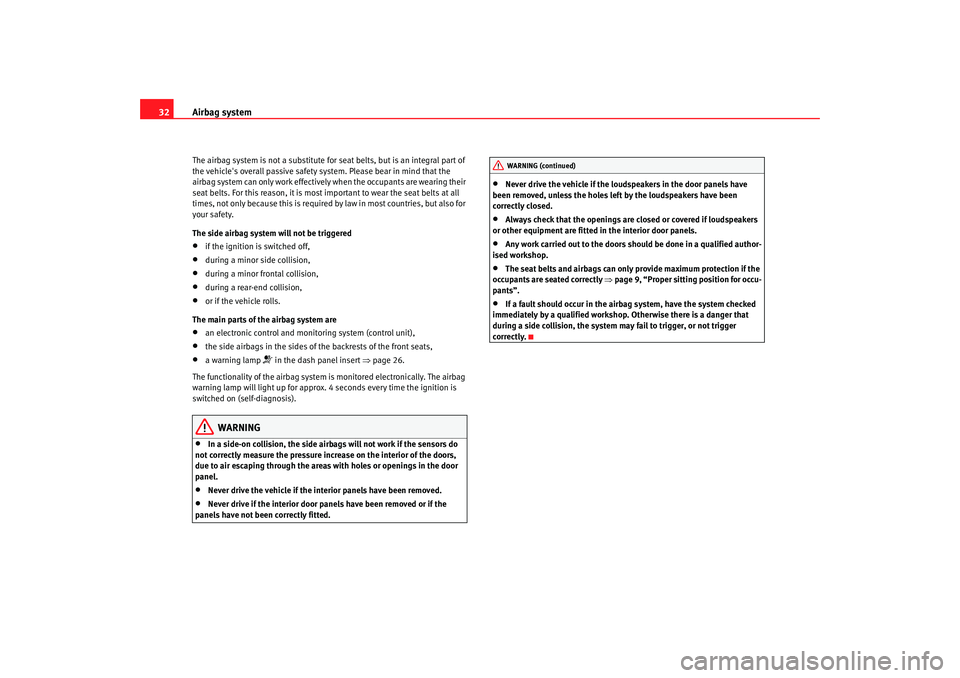
Airbag system
32The airbag system is not a substitute for seat belts, but is an integral part of
the vehicle's overall passive safety system. Please bear in mind that the
airbag system can only work effectively when the occupants are wearing their
seat belts. For this reason, it is most important to wear the seat belts at all
times, not only because this is required by law in most countries, but also for
your safety.
The side airbag system will not be triggered•
if the ignition is switched off,
•
during a minor side collision,
•
during a minor frontal collision,
•
during a rear-end collision,
•
or if the vehicle rolls.
The main parts of the airbag system are
•
an electronic control and monitoring system (control unit),
•
the side airbags in the sides of the backrests of the front seats,
•
a warning lamp
in the dash panel insert ⇒page 26.
The functionality of the airbag system is monitored electronically. The airbag
warning lamp will light up for approx. 4 seconds every time the ignition is
switched on (self-diagnosis).
WARNING
•
In a side-on collision, the side airb ags will not work if the sensors do
not correctly measure the pressure increase on the interior of the doors,
due to air escaping through the areas with holes or openings in the door
panel.
•
Never drive the vehicle if the interior panels have been removed.
•
Never drive if the interior door panels have been removed or if the
panels have not been correctly fitted.
•
Never drive the vehicle if the loudspeakers in the door panels have
been removed, unless the holes left by the loudspeakers have been
correctly closed.
•
Always check that the openings are closed or covered if loudspeakers
or other equipment are fitted in the interior door panels.
•
Any work carried out to the doors should be done in a qualified author-
ised workshop.
•
The seat belts and airbags can only provide maximum protection if the
occupants are seated correctly ⇒page 9, “Proper sitting position for occu-
pants”.
•
If a fault should occur in the airbag system, have the system checked
immediately by a qualified workshop. Otherwise there is a danger that
during a side collision, the system may fail to trigger, or not trigger
correctly.WARNING (continued)
ibiza_angles_0706_DEF Seite 32 Freitag, 1. September 2006 1:18 13
Page 36 of 268
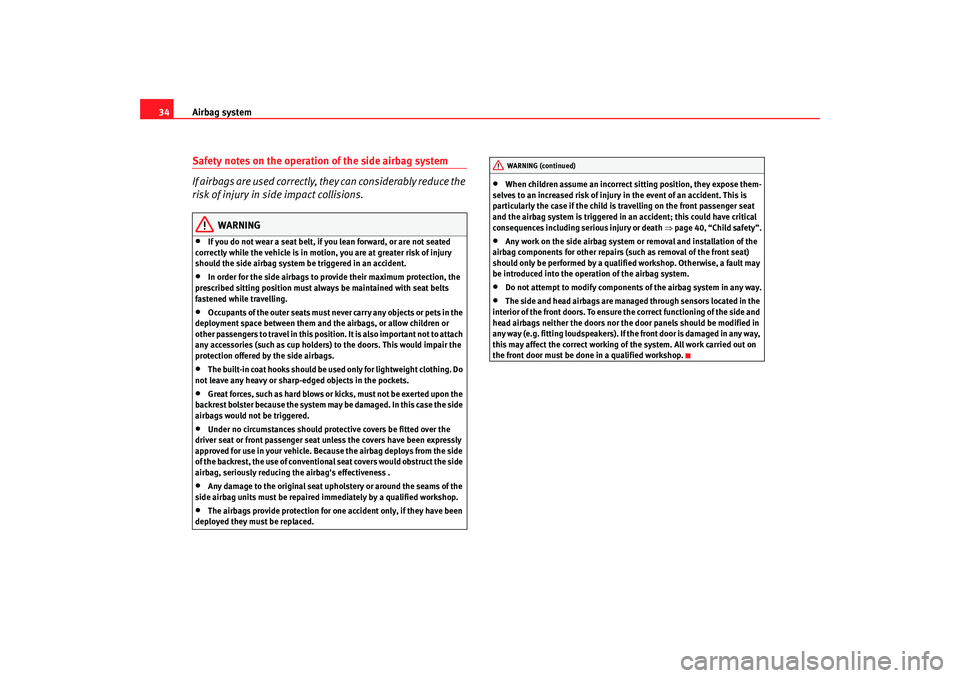
Airbag system
34Safety notes on the operation of the side airbag system
If airbags are used correctly, they can considerably reduce the
risk of injury in side impact collisions.
WARNING
•
If you do not wear a seat belt, if you lean forward, or are not seated
correctly while the vehicle is in motion, you are at greater risk of injury
should the side airbag system be triggered in an accident.
•
In order for the side airbags to provide their maximum protection, the
prescribed sitting position must always be maintained with seat belts
fastened while travelling.
•
Occupants of the outer seats must never carry any objects or pets in the
deployment space between them and th e airbags, or allow children or
other passengers to travel in this position. It is also important not to attach
any accessories (such as cup holders) to the doors. This would impair the
protection offered by the side airbags.
•
The built-in coat hooks should be used only for lightweight clothing. Do
not leave any heavy or sharp-edged objects in the pockets.
•
Great forces, such as hard blows or kicks, must not be exerted upon the
backrest bolster because the system may be damaged. In this case the side
airbags would not be triggered.
•
Under no circumstances should protective covers be fitted over the
driver seat or front passenger seat unless the covers have been expressly
approved for use in your vehicle. Because the airbag deploys from the side
of the backrest, the use of conventional seat covers would obstruct the side
airbag, seriously reducing the airbag's effectiveness .
•
Any damage to the original seat upho lstery or around the seams of the
side airbag units must be repaired immediately by a qualified workshop.
•
The airbags provide protection for one accident only, if they have been
deployed they must be replaced.
•
When children assume an incorrect si tting position, they expose them-
selves to an increased risk of injury in the event of an accident. This is
particularly the case if the child is travelling on the front passenger seat
and the airbag system is triggered in an accident; this could have critical
consequences including serious injury or death ⇒page 40, “Child safety”.
•
Any work on the side airbag system or removal and installation of the
airbag components for other repairs (such as removal of the front seat)
should only be performed by a qualified workshop. Otherwise, a fault may
be introduced into the operation of the airbag system.
•
Do not attempt to modify components of the airbag system in any way.
•
The side and head airbags are managed through sensors located in the
interior of the front doors. To ensure the correct functioning of the side and
head airbags neither the doors nor the door panels should be modified in
any way (e.g. fitting loudspeakers). If the front door is damaged in any way,
this may affect the correct working of the system. All work carried out on
the front door must be done in a qualified workshop.WARNING (continued)
ibiza_angles_0706_DEF Seite 34 Freitag, 1. September 2006 1:18 13
Page 39 of 268
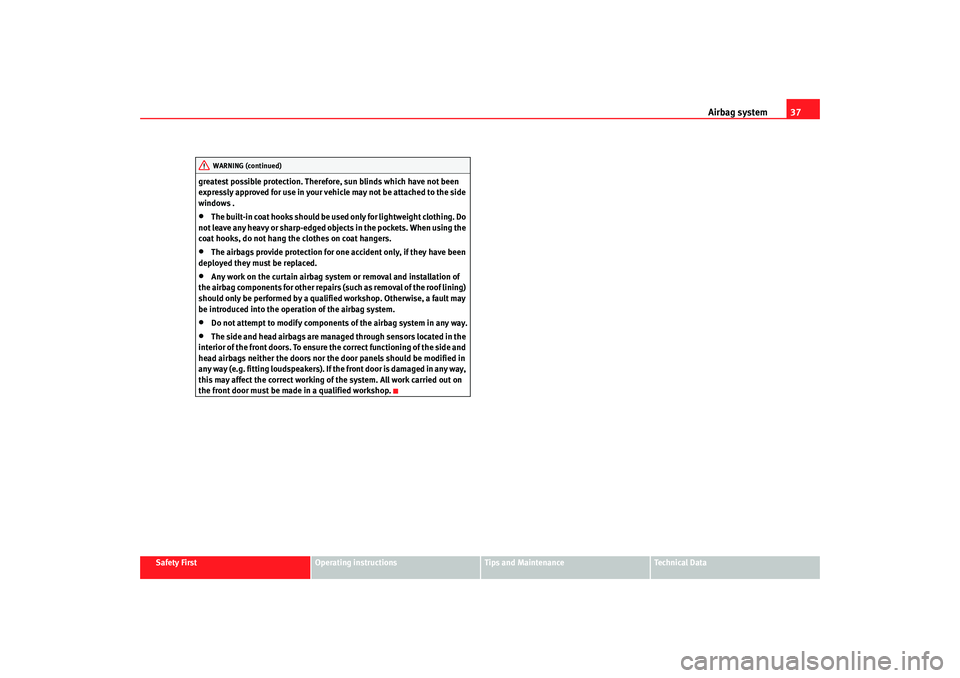
Airbag system37
Safety First
Operating instructions
Tips and Maintenance
Te c h n i c a l D a t a
greatest possible protection. Therefore, sun blinds which have not been
expressly approved for use in your vehicle may not be attached to the side
windows .
•
The built-in coat hooks should be used only for lightweight clothing. Do
not leave any heavy or sharp-edged obje cts in the pockets. When using the
coat hooks, do not hang th e clothes on coat hangers.
•
The airbags provide protection for one accident only, if they have been
deployed they must be replaced.
•
Any work on the curtain airbag system or removal and installation of
the airbag components for other repairs (such as removal of the roof lining)
should only be performed by a qualified workshop. Otherwise, a fault may
be introduced into the operation of the airbag system.
•
Do not attempt to modify components of the airbag system in any way.
•
The side and head airbags are managed through sensors located in the
interior of the front doors. To ensure the correct functioning of the side and
head airbags neither the doors nor the door panels should be modified in
any way (e.g. fitting loudspeakers). If the front door is damaged in any way,
this may affect the correct working of the system. All work carried out on
the front door must be made in a qualified workshop.WARNING (continued)
ibiza_angles_0706_DEF Seite 37 Freitag, 1. September 2006 1:18 13